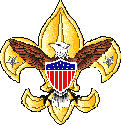| MERIT BADGES |
|
|
|
|
| Note: Eagle Required are in Italics |
"A"
American
Business
American Culture
American Heritage
American Labor
Animal Science
Archaeology
Archery
Architecture
Art
Astronomy
Athletics
Atomic Energy
Auto Mechanics
Aviation
"B"
Backpacking
Basketry
Bird Study
Bugling
"C"
Camping
Canoeing
Chemistry
Cinematography
Citizenship
Community*
Citizenship Nation*
Citizenship World*
Climbing
Coin Collecting
Collections
Communications*
Computers
Cooking
Crime Prevention
Cycling*
"D"
Dentistry
Disability Awareness
Dog Care
Drafting
"E"
Electricity
Electronics
Emergency
Preparedness**
Energy
Engineering
Entrepreneurship
Environmental
Science*
"F"
Family Life*
Farm Mechanics
Fingerprinting
Fire Safety
First Aid*
Fish & Wildlife Mgmt.
Fishing
Fly Fishing
Forestry
"G"
Gardening
Genealogy
Geology
Golf
Graphic Arts
"H"
Hiking
Home Repairs
Horsemanship
"I"
Indian Lore
Insect Studies
"J"
Journalism
"K"
"L"
Landscape Architecture
Law
Leatherwork
Lifesaving**
"M"
Mammal Study
Medicine
Metalwork
Model Design & Building
Motorboating
Music
"N"
Nature
"O"
Oceanography
Orienteering
"P"
Painting
Personal Fitness**
Personal Management*
Pets
Photography
Pioneering
Plant Science
Plumbing
Pottery
Public Health
Public Speaking
Pulp and Paper
"Q"
"R"
Radio
Railroading
Reading
Reptile & Amphibian Study
Rifle Shooting
Rowing
"S"
Safety
Salesmanship
Scholarship
Sculpture
Shotgun Shooting
Skating
Skiing
Small Boat Sailing
Soil & Water
Conservation
Space Exploration
Sports**
Stamp Collecting
Surveying
Swimming**
"T"
Textile
Theatre
Traffic Safety
Truck Transportation
"U"
"V"
Veterinary Medicine
"W"
Water Skiing
Weather
Whitewater
Wilderness Survival
Wood Carving
Woodwork
"X"
"Y"
"Z"
 Geology GeologyRequirements 1985 |
Explain what geology means.
Earth Materials- Make a collection of at least 10 different earth materials or geological specimens from
your locality or an area of special interest to you. Label, to the best of your ability,
classify, and explain the origin and use of the materials collected.
- Alternatives: In place of requirement 2, you may present a collection of 10 different rocks, with specimens of sedimentary, igneous, and metamorphic rocks properly marked, cataloged, and displayed.
- Or you may present a collection of 10 different minerals (or ores) properly marked, cataloged, and displayed. Also identify each of the 10 minerals, and give their sources and possible uses.
- Define rock. Discuss and define three classes of rocks. List the characteristics of each class, how they are formed, and how they are named.
Define mineral. Tell how to identify minerals. Tell how rocks and minerals differ. List five of the most common rock-forming minerals. Tell how they are identified. Tell how hardness, specific gravity, color, streak, cleavage, luster, and crystal form are useful in identifying minerals.
Earth Processes- Secure a topographic map of your how locality or an area of special interest to you. Explain the origin of the landscape, including any unusual features. Account for any influences of the landscape on the location of towns, parks, highways, railroads, airports, industries, or similar structures.
- Draw a diagram of the hydrologic cycle and discuss it and its effects with your counselor.
- Do ONE of the following:
- Tell about the occurrence of volcanos on land and in the ocean. Describe the difference between intrusive igneous rocks and extrusive igneous rocks.
- Describe the major steps in the geologic history of a mountain range. Describe the anticline, syncline, fault, strike, dip and an unconformity. Discuss the relationship between mountain building and erosion in forming the present landscape.
- Describe the major features of an ocean floor between the shorelines on either side.
Earth History - Make a chart showing the geological eras and periods and show in what geologic time the rocks in your region were formed.
- Do ONE of the following:
- Tell what fossils are and how they aid in understanding the story of the earth's history.
- Make a collection of 10 different fossils and identify them to the best of your ability.
- Discuss with your counselor the theory of continental drift.
Geology and People - Discuss two environmental problems related to geology. Tell how land-use planning
relates to geology. Tell why faulting, landslides, waste disposal, pollution, water
supply, and subsidence are important in land-use planning. Give an example of poor use of
land in your area or an environmental hazard in your area related to geologic features or
processes.
- Do ONE of the following:
- Describe five energy sources, how they occur, and how they are used today. Describe the source of the products supplied by your local utilities. Tell which of these products are related to geologic processes.
- Visit a mine, oil or gas field, gravel pit, stone quarry, or similar area of special interest to you. Make a collection of geologic specimens found at the site visited. Tell about the geology of the place.
Careers in Geology - Do ONE of the following:
- Read a pamphlet about careers in geology. Tell what you learned.
- Visit with a geologist, other than your counselor. Tell what he or she does. Find out how he or she prepared for the job.
- Discuss with your counselor what you have learned about careers in geology and how to prepare for them.
|
||||||
Last Update May 15, 2023

.jpg)
